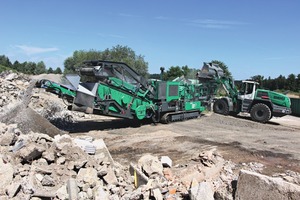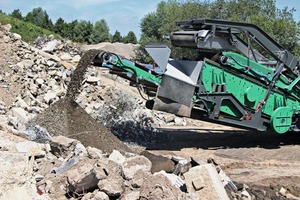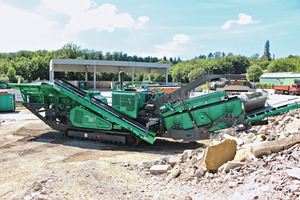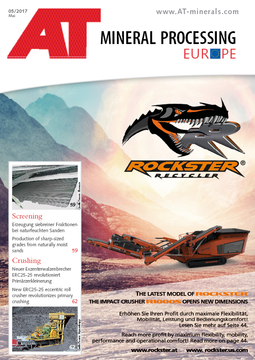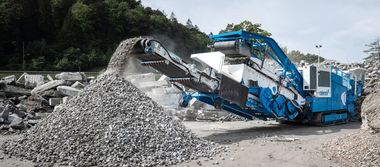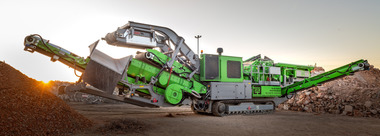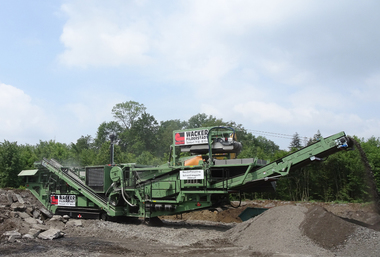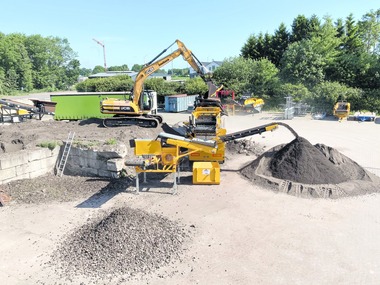Track-mounted impact crusher with screen unit
Harsch-EBRD, a group of companies based in Bretten between Stuttgart and Karlsruhe in Southern Germany, is combating the increasing volume of materials from reconstruction and the higher requirements for recycling construction materials with an investment in a track-mounted impact crusher with screen unit from the Swiss manufacturer GIPO. With this investment, the recycling company EBRD is underlining its objective in the construction industry with impulses for avoiding waste and the use of waste-derived construction materials.
As a founding member of the “Quality Assurance System for Recycled Construction Materials in Baden-Württemberg Regd.” (QRB), EBRD and the materials it recycles undergo regular checks at the construction material testing centre in Karlsruhe as well as in-house production testing. The recycled 0/45 ballast mix from EBRD is approved for use as a frost protection course as well as a base course in road construction and has therefore earned the same approval as comparable quarried material.
For more than a quarter of a century, EBDR has operated a construction materials recycling plant. Here, demolition material from commercial and private deconstruction projects is recycled for reuse in the materials cycle. To handle the increasing volume of material, EBRD has replaced the older stationary recycling plant with a new, high-capacity GIPOREC R131 FDR GIGA special impact crusher. Here the company selected a larger machine than originally planned, of which the Swiss manufacturer GIPO has already delivered a dozen machines – three of which to Germany. The machine for EBRD with an operating weight of 60 t was delivered in May and started production in early summer. The feed hopper for the crusher inlet with an opening of 1270 x 920 mm and a rotor diameter of 1200 mm was heightened on customer request and has a capacity of 7.5 m3.
Plant mobility brings wider application possibilities
The decision to buy a new plant from GIPO was preceded by a year-long evaluation process with intensive talks, machine inspections in Switzerland and the incorporation of customer requirements, which goes back to bauma 2013. The decision took account of crucial arguments such as individualization in production and innovative one-off solutions such as heightened feed hopper, iron discharge in the lengthways direction, air classifier and automatic lubrication, as a result of which servicing and maintenance are minimized. Another deciding factor was the low-emission drive with a CAT diesel engine and the service and replacement parts offered direct from Switzerland. “EBRD processes a volume of around 60 000 t per year. The GIPO plant operated by only one machinist was to run 800 operating hours a year and reach the 10 000 operating hours expected in 10-12 years,” reports Thomas Zehlicke, Operations Manager at EBRD.
The better separation possibilities during processing with the GIPO crusher contribute to a considerable increase in quality of the recycled material. With the magnetic separator, iron reinforcements from reinforced concrete can be removed more efficiently while lightweight, undesirable elements, e.g. polystyrene, wood, and films, can be blown out of the recycled rubble by means of the air classifier. The mobility of the crusher is described by the Operations Manager as another plus point. Thanks to the tracks, the GIPOREC R131 can be moved over large construction sites and used for processing building rubble on site in large deconstruction projects. “This takes the load off the roads as the demolition materials remain on site and can be used for in possible rebuild projects,” Zehlicke emphasizes.
Technical crusher features
The basic impact crusher model can be extended to meet customer requirements, and it can be operated and transported with or without screen unit. This further developed impact crusher can be used to screen crushed material so that a qualified product grain can be produced.
The GIPOREC R131 FDR GIGA special is equipped with the P131 impact crusher with two impact rockers, an adjustable feed inlet of 1270 x 920 mm and a rotor with an impact circuit diameter of 1200 mm. Further, the unit has a reinforced discharge trough, a 1400-mm-wide crusher discharge belt, iron discharge in the lengthways direction and a two-deck wet screen. The plant can be used for processing natural rock and recycling. Up to four product sizes can be produced in one crushing operation.
With the separate 2-deck pre-screening, the quality of the final product can be improved with the removal of wear-intensive fines, from platy particles and any impurities. On the lower deck, depending on the quality of the feed material, a wire screen grate can be used. The impact mill discharge with a discharge trough and a 1400-mm-wide crusher discharge belt prevents material building up under the rotor and the transfer points. As a result, the height of the material bed can be reduced. Especially in recycling, this has a positive consequence as iron components can be better picked up by the overbelt magnetic separator and removed.
The crushed material is screened by the big screening machine with a screening area of 1500 x 5000 mm. The oversize can be discharged either at the side or recirculated to the feeder. The oversize recirculation conveyor belt can be slewed hydraulically by 180 degrees on a stable rotating console and can be used for stockpiling.
The easy connection and disconnection of the screen unit to the crusher is done with a hydraulic cylinder without an additional hoisting equipment. The screen unit is connected and disconnected in less than ten minutes. Thanks to the good accessibility, easy and fast change of the screening surface is possible. For crusher operation, the crushing and screening unit does not need additional supports. The plant can therefore be operated and moved without restrictions.

